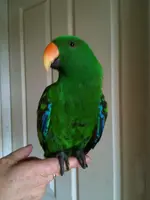Robyn
New member
- Sep 9, 2009
- 169
- 5
Hello,
I have recently gained a 2nd male ekky aged 2 yrs old, my other male ekky is 2 yrs and 3 months old and I have had him since he was 14 weeks old.
There is a big difference between my 2 . I do know there is sub species but my main concern is that my one I have had since he was 14 weeks old .... doesnt have the striking green colouring that my newer ekky has. Also my ekky has smaller black feet and my new one has quite big white or cream coloured feet.
Jacks feathers are quite dark, his red feathers are not seen , but right under his wings. I have always seen photos of ekkys where you can see their red feathers, Jacks is NOT visible at all you can see a bit of blue at the top rim of his wings and his beak is not bright or candy corn coloured , but the deep yellow is there. He was taken to the vets and they said there is nothing wrong with him, he is a very happy chirpy boy, always has been.
Our newer Ekky just turned 2 , we have had him about 3 weeks now, he is 3 months younger than Jack but much bigger, beautiful very bright green feathers, red feathers are very visible from under his wings showing at the sides of his belly, big candy corn beak , very bright and big whitish coloured feet.
So my main concern is ..... Is Jack ok ? or is he some sort of runt ??? I have yet to see a photo or hear of somebody who has an ekky with small black feet whose red feathers are not visible.
Thanks..
I have recently gained a 2nd male ekky aged 2 yrs old, my other male ekky is 2 yrs and 3 months old and I have had him since he was 14 weeks old.
There is a big difference between my 2 . I do know there is sub species but my main concern is that my one I have had since he was 14 weeks old .... doesnt have the striking green colouring that my newer ekky has. Also my ekky has smaller black feet and my new one has quite big white or cream coloured feet.
Jacks feathers are quite dark, his red feathers are not seen , but right under his wings. I have always seen photos of ekkys where you can see their red feathers, Jacks is NOT visible at all you can see a bit of blue at the top rim of his wings and his beak is not bright or candy corn coloured , but the deep yellow is there. He was taken to the vets and they said there is nothing wrong with him, he is a very happy chirpy boy, always has been.
Our newer Ekky just turned 2 , we have had him about 3 weeks now, he is 3 months younger than Jack but much bigger, beautiful very bright green feathers, red feathers are very visible from under his wings showing at the sides of his belly, big candy corn beak , very bright and big whitish coloured feet.
So my main concern is ..... Is Jack ok ? or is he some sort of runt ??? I have yet to see a photo or hear of somebody who has an ekky with small black feet whose red feathers are not visible.
Thanks..


